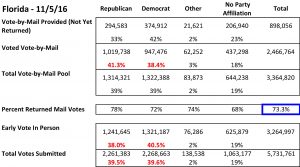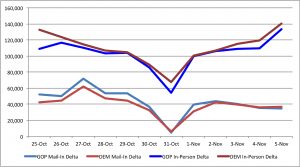Nov 05 2016
FL Early Voting 11_05_16: Dems Squeak Out To Tiny Lead
The Democrats have finally overtaken the GOP in Florida with the final vote tallies. This was due to a strong showing Friday.
Dems lead the GOP by 7,280 ballots. They lead the In-Person vote by 2.5% while the GOP leads the Mail-In vote by 2.9%. The In-Person voters have outnumbered the Mail-In voters on a daily basis, but the Mail-In voting has been going on longer. That is why it took nearly all the In-Person voting to date to erase the GOP lead in ballots – for now at least. We have Saturday and Sunday to finish out In-Person voting.
Bottom line – the early vote is a tie with 39.5% GOP, 39.6% DEM and 21.5% for the remaining categories. I will come back to this chart in a bit, but let’s look at the trend over the last two weeks first:
As we can see, the Democrats had a banner day Friday with In-Person voting, which is why they jumped out into the lead. But the GOP voters were not slouches either. They also upped their game and had a surge in In-Person. While I have not been tracking the Independents (No Party Affiliation), they have also kept up the pace as well. Earlier this week the two remaining groups accounted for 19% of the total votes. Today it is 21.5%. So turnout is big, and across the board.
This is why the bottom line percentages are stable and likely to lock in.
So , is this good for Clinton or Trump?
Interestingly, AllahPundit over at Hot Air posted about Pennsylvania yesterday. In it he referenced this article about Florida:
Democrats like what they see, party executive director Scott Arceneaux told the Times/Herald. Democrats are outpacing Republicans in mail ballot requests for the first time and early voting is much higher than in 2012. The fact that African-American turnout has been slower than in 2008 or 2012 is not a major concern, he said, and the party will use black churches on Sunday to coordinate a massive get-out-the-vote effort known as Souls to the Polls.
Emphasis mine. OK, two things to note here. When this was written the Dems did not have the lead in overall ballots, they were behind by 1,833. So the only ray of sunshine in the first table above is the number of mail-in ballots requested. But the real number to look at is mail-in ballots returned! The GOP has led that number, and they lead in the percentage of requested ballots returned (78-72%, 4th row in the table above).
We know the Democrat Machine requests mail-in ballots in large lots. So this not a feat or a significant indicator. The turnout is clear, the GOP mail-in voting is better than the Democrat.
The second highlight is an admission, because this is data is not public as far as I know. African American turnout is lower than 2012. Therefore I am not buying this person’s Democrat Happy Talk. The article makes one final point I have been making throughout this series of posts – Dems are not winning the Early Vote like they did in 2012:
Four days out four years ago, Democrats narrowly led Republicans in early and mail voting by 101,000 votes out of 3.2 million cast. Republicans did win in Election Day turnout, but President Barack Obama still won Florida by just under 1 percent.
So when Obama squeaked out his win in 2012, at this stage the Dems were ahead by 101,000 ballots out of 3.2 million cast (the 3.15% – the margin I noted in prior posts). Today the Dems lead by paltry 7,280 ballots out of 5,731,761 cast (0.13%). Obama would not have won Florida with the numbers we see today in 2016.
AllahPundit was using Florida as an example of tight races and turnout model errors. So lets go back to his post and dig a bit.
These same analysts will tell you, quite rightly, that once a candidate’s lead shrinks to three points or so, the risk that the polls will miss predicting the winner starts to get real. Polls of likely voters are based on turnout estimates across various key demographics; when the lead is down to three, even small mistakes in those estimates can overlook an upset brewing.
And this is why I disagree with the pollsters in Florida. What we have in that table up top is not a poll, but actual turnout data. It is not a model. It shows the GOP, Dems and remaining two groups in a unique configuration:
- 39.5 GOP
- 39.6 Dem
- 21.4 The Rest
If Trump does lead in the Independents, then …
Well I will let some folks at RealClearPolitics explain:
Barack Obama won re-election largely because 5 to 6 percent more Democrats went to the polls in 2012 than Republicans, and because the president persuaded well over 90 percent of them to vote for him. Thus, even though Mitt Romney did very well among Republicans, he had to make up that 6 percent gap by drawing more Independents.
Well in Florida (and Colorado) the edge in party turnout is not happening.
The answer is that education levels are a more significant factor this year. Obama won a majority of those with a high school diploma (or less) in 2012, while Romney won college-educated voters. This year the numbers are reversed. Among white voters with only a high school education, Trump leads by over 25 points. Among whites with a college degree, Clinton leads by about 10 percent.
This is the first time since serious polling began in 1952 that this has happened. The traditional pattern of Democratic support among blue-collar workers this year follows the high-school-or-less pattern with white, blue-collar workers preferring Trump to Clinton. These unique combinations of less support for traditional party loyalties across education levels accounts for the narrow Clinton lead of four points in our latest poll. Another example, which makes the point, is that women with less education are voting for Trump while college-educated women are very strong for Clinton, which cuts into the gender gap and makes Clinton’s lead among women slightly less than Obama’s was in the previous election.
The takeaway here is you cannot rely on party ID to predict votes. The primary predictor will be education level (a.k.a. economic status). Where Trump is winning is in the lesser educated (and much more numerous) element of the population who are struggling economically. It is this group which is likely surging to vote and pushing all party affiliation participation to new highs.
I can’t see Hillary being such a vote magnet. This is how Trump vanquished his traditional opponents in the primaries. By energizing those living below the “upper middle class” to play in the primaries, and by stealing a good number of the “upper middle class” themselves. If the general election turnout reminds me of anything, it is the primary turnout for Trump
Finally something about independents:
This leaves Independents, who almost by definition are more susceptible to alterations in the political environment. Trump has made some progress since the last poll, going from nine points ahead of Clinton to 11 points. Partly, this is because the number of voters saying they were undecided or voting for third party candidates has been cut in half. By Election Day, their ranks will be thinned even further.
If Hillary has indeed lost Les Deplorables across all parties and Independents
, she is not going to win next week. In fact, it would be a very, very good night for Trump if this is true. If you are a Hillary supporter, all you have to hold onto is trust in the turnout models.








Very good analysis. I hope you also do one for Nevada. People are freaking out over the early voting results from that state.
Back to the topic of Florida. The early voting results give us a D/R/I breakdown of 39.58/39.45/20.97 which give us D+.13
Back in 2012 D/R/I was 35/33/33 which gives us D+2, so at least with early voting and mail-in ballots we have closed the gap. Hopefully we will see more “R’s” and “I’s” voting on Election Day. It will be interesting to see how many “D’s” will be voting for someone other than Clinton and likewise how many “R’s” are never-Trumpers.
A few other points:
In 2012 blacks made up 13% of the Florida vote and Obama won them by 95%. I would like to think that will not be repeated anywhere near that figure. I think Trump will win a higher than usual share of the black vote compared to previous GOP candidates.
In 2012 Hispanics made up 17% of the Florida vote and Obama won 60%.
It is probably safe to assume that number has gone up. How much, I do not know. The question is how many are turned off by Trump’s stance on illegal immigration. I don’t believe it is as bad as the media wants to portray.
In 2012 those who never went to college made up 22% of the Florida vote. Obama won 52% of them. Like you, I believe we will likely see an increase of them this year and that Trump will win a majority of those voters.
In 2012 the Independent vote made up 33% of the Florida vote. Obama won that 50% to Romney’s 47%. It is encouraging to see Trump extend his lead with Independents and I expect that to continue.
One more thing, looking at the nearly similar number of Dem and GOP early votes makes me wonder if crowd sizes at rallies are not a good indicator of turnout. Given the larger crowd size at Trump’s rallies made me think that the GOP number would be much, much higher. Perhaps we will see that on Election Day?
There is a case to be made that immigrant Hispanics will not support Clinton since she and Obama have allowed in millions of Arab and Persian “refugees” who are now competing for the same jobs as the Hispanics. The Hispanics my have become so embedded in America they do not want to see their jobs threatened by a new immigrant wave
[…] in 2012, the breakout of voters by party (per this comment) was 35D-33R-33I. So what we see in 2016 is that Hillary Clinton is performing well below […]
[…] If this holds even somewhat true nationally, Clinton will lose in a landslide. From another previous post on Florida, we have this RCP link: […]